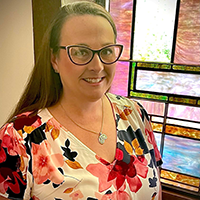Acute Intermittent Porphyria (AIP)

It all started my junior year of college, but I didn’t know it then. I was chronically anemic, fatigued, and depressed. I chalked it up to poor diet, because no one could find anything wrong. Six years later, I had my first attack. The ER Dr told me I had a big “gas bubble” and sent me home with some magnesium citrate. Obviously, to them I was just being a big baby. The depression continued along with various other symptoms that were easily explainable as other things at the time.
The next attack would occur about a month after the birth of my daughter. It MUST be my gallbladder, even though all tests came back negative. One lap chole later, that pain should be gone. Guess again! Attacks continued every few months for the next several years. No one ever had any idea as to what was causing these mysterious episodes. In 2021, I had gastric sleeve surgery. That’s when the attacks really ramped up in severity. They came several times per month. Sometimes my arms and legs would quit working for bit after an attack, sometimes I would struggle to breathe, sometimes I would almost pass out.
Each attack is different, but the one constant is the debilitating pain. It was worse than c-section without anesthesia pain. It’s like being stabbed in the liver with a hot knife, and then someone drags that deep knife straight across my abdomen. My blood pressure goes up dramatically, my pulse goes up above 150, I hyperventilate, anxiety is through the roof, my urine turns dark orange, sometimes there is nausea, often there is diarrhea . Sometimes my arms and legs quit working or just get tingly, not to mention the random and weird pains all over for seemingly no reason.
Then I met my new PCP. He actually listened to me. He sent me to a gastroenterologist for a consultation. He actually listened to me, too, and the question of porphyria came to his mind. Now I had to wait for the next attack to get tested so we could test properly. Of course, that would be months later! As soon as it happened, i got my butt straight to his clinic and said, "Let’s test for porphyria." I’d never heard of that word previously. The values were off the charts. He said in his 25 years of practice, he’d only ever seen one other person with porphyria. To have a name put to this misery was a weight lifted off of my shoulders. It meant I wasn’t crazy. I wasn’t just a big baby. AIP (acute intermittent porphyria) was about to become a common word in my household. Let the research begin!
The cardiologist had me wearing a holter monitor for a month to see if we could catch any funky rhythms that might happen during an attack. The result was “inconclusive, but he said, "here’s a beta-blocker.” Next stop was a hematologist. He knew nothing and didn’t seem to really be interested. I had a heart-to-heart with my PCP, and we decided we would learn about this porphyria thing together. I’m thankful for him every day. The closest expert was 8 hrs away. That’s coming up soon on my to-do list.
Over the last couple of years, I have trained my dog (Simon) to call out for help should an attack make me lose consciousness. What good could a little chihuahua do in an emergency? Well if you need to get someone’s attention, what better than a yappy dog? When he puts on his vest, he’s all business. Having him with me has given me back piece of mind that I can go some by myself again and be alright if I have an attack. He is even tuning in to when the attacks begin building. (Pays better attention to me than my kids do)
I do worry about passing this to my kids. I have begun to suspect signs and symptoms with my daughter and will have her tested in the near future. For now, all we can do is take each day as it comes. Repeat after me….”right foot, left foot, right foot, left foot.”
